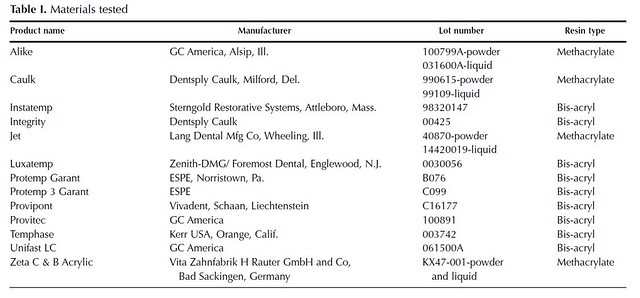Jeff,
The pdf link was for "Temporary Bridge Resin" which is a PMMA, so I agree, the material you posted in the link above is definitely for a methacrylate. Go back to that page and click the "Directions for Use" on the top of the page, it is for Integrity. Link:
http://www.dentsply.com/assets/DFU/Integrity_English.pdf
I can tell from your posts that you are a good dentist and a quality operator, please do not take my previous post as condescending. It was merely to emphasize that we should know all about our materials prior to or in conjunction with knowing how to use them really well. Now knowing the chemistry is probably not necessary, but knowing the information in the Christensen article I posted above certainly will help with your clinical handling of the materials (i.e. which can you reline?, which can you brush bead with flowable composite?, which shrinks the most?, which has the highest hardness? which is the most brittle? etc etc etc.)
Knowing these things really does matter in daily clinical practice because if your provisionalizing a single unit that is to be replaced in 2 weeks with a final crown and you want your assistant to make really quick, a Bis-acryl works fantastic (i.e. ProTemp, Integrity, Luxatemp). But say you are preparing a full arch (14 teeth) and wanting to have the patient in provisionals for 6 months while they are away on a cruise around the world and wants to be able to eat lamp chops in Greece... maybe you should consider a heat/pressure cured PMMA (i.e. Jet, C&B resin).
Integrity is a Bis-acryl resin which, while could
possibly be derived from a metacrylate, is widely considered a composite resin rather than a methacrylate. It is, however, certainly is not a PMMA.
Also, see these published references:
---------------
J Prosthet Dent. 2001 Feb;85(2):129-32.
Comparative in vitro evaluation of two provisional restorative materials.
Young HM, Smith CT, Morton D.
Department of Operative Dentistry, College of Dentistry, University of Florida, Gainesville, FL 32610, USA.
[email protected]
Abstract
STATEMENT OF PROBLEM: Provisional crowns traditionally have been associated with problems such as poor occlusion, contour, fit, and finish. Fabrication procedures should be uncomplicated and predictable within a realistic time frame.
PURPOSE: The purpose of this study was to compare the quality of provisional restorations fabricated by dental students from 2 different materials (bis-acryl composite resin and PMMA) and identify the advantages and disadvantages associated with each material.
MATERIAL AND METHODS: This study evaluated the occlusion, contour, marginal adaptation, and finish of 222 provisional crowns fabricated by 2 groups (A and B) of dental students. One bis-acryl composite resin material (Integrity) and 2 PMMA resins (C&B Resin and Snap) were evaluated.
RESULTS: For group A, Integrity was statistically superior (P<.05) to C&B Resin in all 4 categories for anterior provisional crowns. For posterior provisional crowns, Integrity proved superior in the categories of contour and marginal adaptation, but no significant differences were established for occlusion and finish. For group B, Integrity was statistically superior to Snap in the categories of occlusion, contour, and marginal adaptation, whereas there was no statistical difference in finish. When all 4 categories were analyzed, Integrity was found to be statistically superior.
CONCLUSION: Bis-acryl composite resin (Integrity) was significantly superior to PMMA (C&B Resin and Snap) as a provisional restorative material.
-----------
Taken from:
Haselton DR, Diaz-Arnold AM, Vargas MA. Flexural strength of provisional crown and fixed partial denture resins. J Prosthet Dent. 2002 Feb;87(2):225-8.
Integrity and Jet are right next to each other.
-----------
Great summary of materials:
http://www.insidedentistry.net/article.php?id=1840
-----------
Again, not trying to start an argument or to start a fight, but the literature is clear.


 You more than make up for the extra cost of the Bis GMA in chair time saved.
You more than make up for the extra cost of the Bis GMA in chair time saved.